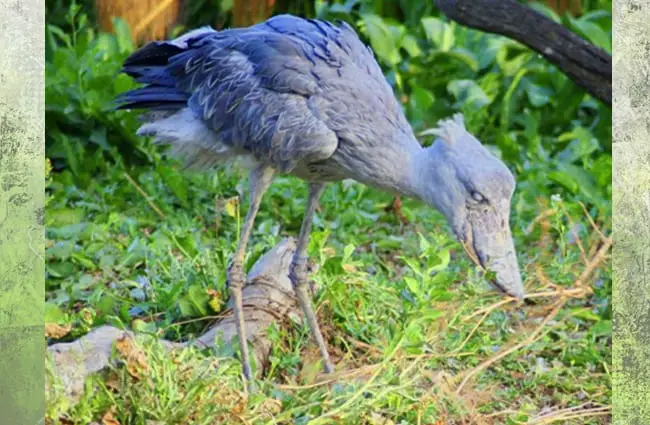

Shoebill (Balaeniceps rex), whalehead, whale-headed stork, shoe-billed stork Communication

If it is already flying, it uses air currents for this. As it is very large – it is rare to see it in flight. Researchers observing these birds may approach the nest less than 2 meters (6.5 ft), and the shoebill will not attack them. They form loose groups only when food is scarce and they are forced to forage next to each other. Shoebill (Balaeniceps rex), whalehead, whale-headed stork, shoe-billed stork Lifestyle Such strikes are repeated several times, but the entire attack lasts no more than 10 minutes.įish that are prey to shoebills are usually from 15 to 50 centimeters and weigh up to 500 grams. They catch it by dropping their neck abruptly towards the water’s surface. Shoebill can stand and wait for its prey. The most suitable place for the shoebill to hunt is shallow, poorly oxygenated water and the vicinity of tall vegetation that provides the bird with camouflage. The diet of these birds is supplemented by frogs, monitor lizards, turtles, young crocodiles, mollusks and carrion. They eagerly eat catfish, tilapia and water snakes. Shoebills feed mainly in aquatic environments, and a large part of their food is lungfish. Shoebill (Balaeniceps rex), whalehead, whale-headed stork, shoe-billed stork Diet

On its back, there is a bunch of protruding feathers. The head also takes on a grayish hue, however darker than the rest of the body. The underside of the body is usually lighter in color – often almost white. The back and neck of the shoebill are covered with blue-gray feathers with a greenish sheen. They are yellowish or gray-white in color. Shoebill’s eyes are relatively large and set forward, which allows them to see better in 3D. It is yellowish in color with small darker spots.Īlthough the neck of a shoebill appears long and slender, it is actually shorter than that of other wading birds such as herons and cranes. The beak has an elongated, wide shape and a hooked end to make it easier to catch slippery fish and rummage through the mud.

Their most characteristic feature, however, is an exceptionally large beak, which looks like a wooden shoe. They have a rather massive torso, slender neck and long, thin legs. Shoebills with the shape of their body slightly resemble storks. Shoebill (Balaeniceps rex), whalehead, whale-headed stork, shoe-billed stork Characteristic They also like to be surrounded by poorly oxygenated waters, because it is easier for them to catch fish that swim close to the surface of the water. These birds also feed on paddy fields and flooded plantations. They like areas with diverse vegetation the most. The appearance of these birds in a given territory strictly depends on the presence of papyrus, cattails and reeds there. Shoebills inhabit vast areas covered with freshwater swamps and those located near rivers and lakes. Shoebill (Balaeniceps rex), whalehead, whale-headed stork, shoe-billed stork Natural environment However, it does not fly more than 500 meters from its previous location. The shoebill is not a migratory bird and only moves periodically due to the availability of food or the disturbance of their natural habitat by humans. Single specimens have also been observed in Kenya, the Central African Republic, northern Cameroon, southwestern Ethiopia, and Malawi. So you can meet him in the territory of Sudan, Zambia, Congo, Rwanda, Uganda and western Tanzania. The shoebill is an endemic species to Africa and inhabits the central-eastern part of the continent. Shoebill (Balaeniceps rex), whalehead, whale-headed stork, shoe-billed stork Occurrence Initially, shoebills were classified as storks (Ciconiiformes), but the latest research has shown that they are closer to pelicans (Pelecaniformes). Researchers observing these birds in their natural environment can approach them at a distance of less than 2 meters (6.5 ft). Despite its rather menacing appearance, the bird is completely harmless to humans. Its most distinctive feature is a huge beak, which resembles a large, hook-like shoe. The shoebill is an unusual bird that occurs naturally only in Africa. Shoebill, whalehead, whale-headed stork, shoe-billed stork


 0 kommentar(er)
0 kommentar(er)
